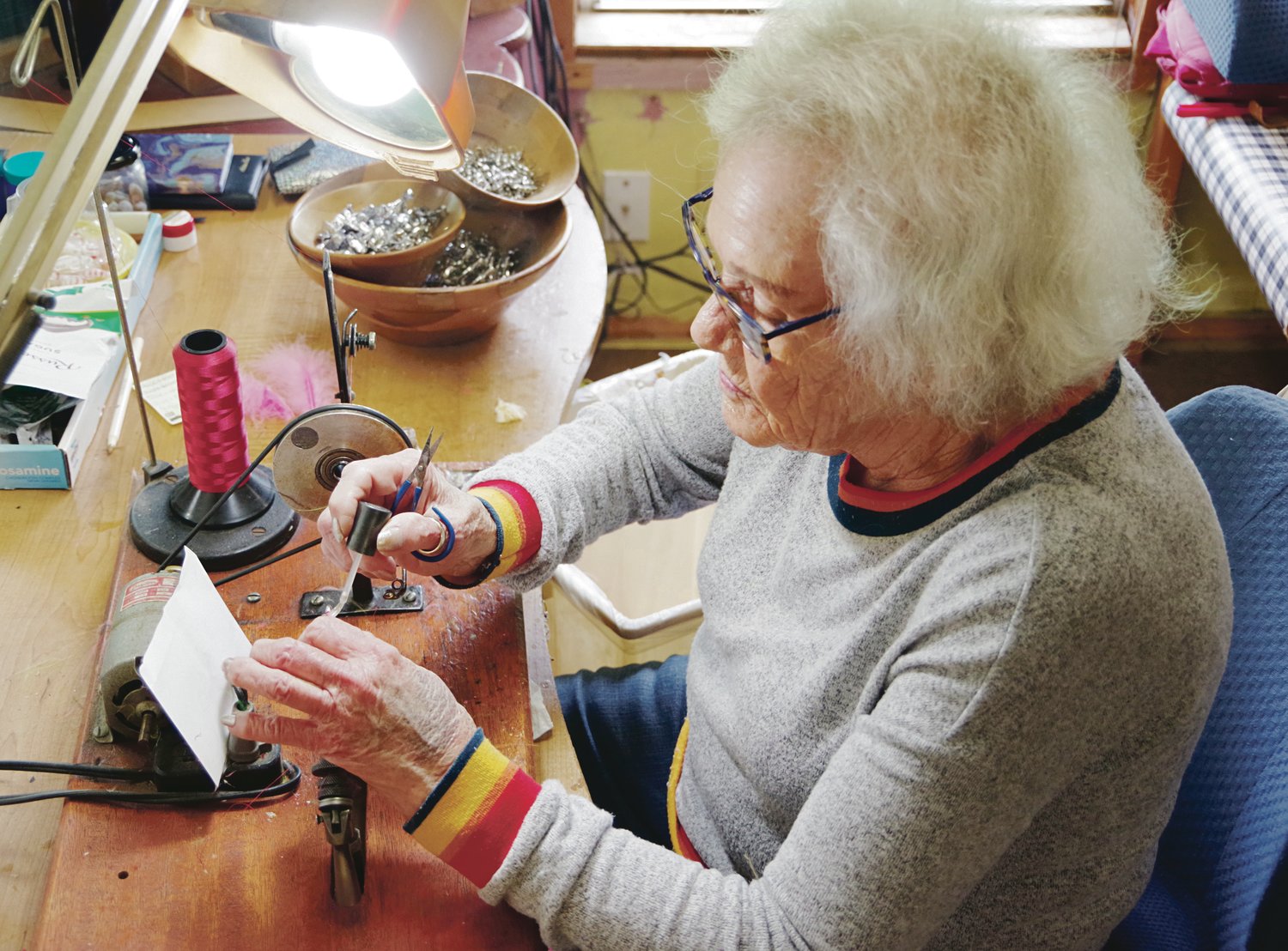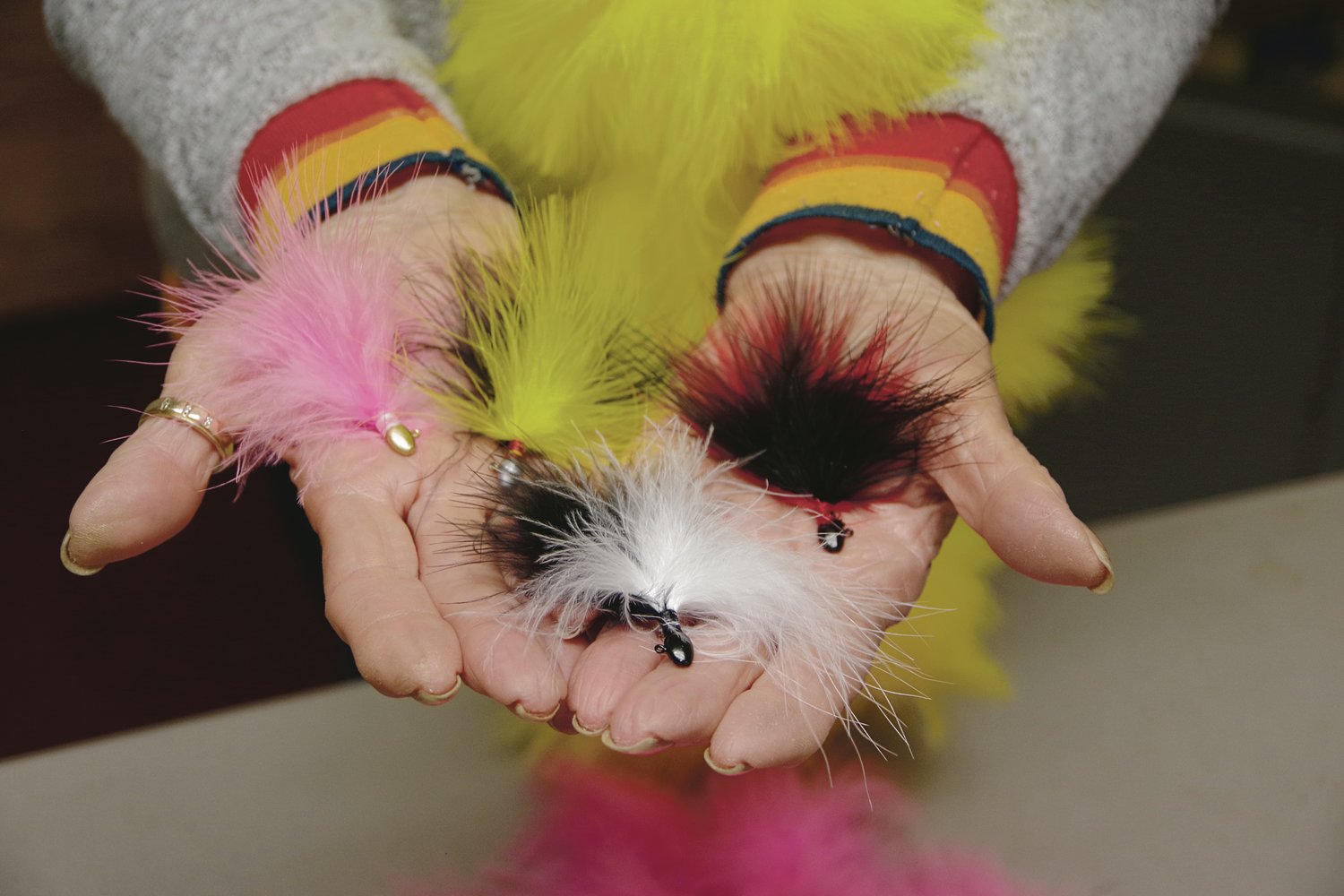Full-Time Fly Tyer
Local long-time jig creator shares story
Bernice Jenkins has never fished in Bennett Spring State Park. However, many of her feather-covered and cotton-like creations take a daily dunk in its cool stream waters.
Her marabou jigs and kapok floating flies are in demand in stores like Weaver’s Tackle Store not just because of the quality, but also because she is one of the few local jig and fly artisans to produce them in large quantities.
At 86, Jenkins has tallied 68 years of fly and jig tying and sufficient skill to watch TV as she works with only a rare mishap.
“This machine winds pretty tight, and sometimes you get your finger caught in it,” Jenkins said.
She has tied flies or jigs her whole working life.
Even during the four years she worked at a Zenith plant, she continued fly tying as her side hustle.
“All my life, this has been about all I’ve ever done – tying these flies. That’s how I’ve paid for everything I’ve got here,” Jenkins said.
After years of producing all types of flies, she now focuses on tying jigs since she can tie them faster and make more money on them.
Selling her flies is how she first met her now boyfriend Paul Weaver, prior owner of Weaver’s Tackle until 1985, where she still sells her jigs. Weaver is one of several store owners in the area to whom she has sold her flies over the decades.
Weaver, 74, said she was the first person to sell him flies, and they were friends who sent each other Christmas cards for years before Jenkins’ husband died.
“Paul Weaver has been a good person in my life. He’s smarter than I am, and he’s really done a lot for me,” Jenkins said.
After her husband passed on, Jenkins was a one-woman operation for a time, including using a single-cavity mold that produced one jig at a time to fill her orders.
Later, Weaver began pouring the jigs using a multi-cavity mold, leaving her to focus on the rest of the process. In a little over an hour, he can pour 40 dozen jig heads.
“That really helps,” Jenkins said.
She credits Luther Hoffman for teaching her how to tie flies when she was 18 years old.
Her output varies with the type of jig she is tying, the method and the chores she needs to do.
For most of her jigs, she uses an electric tier. For the kapok jigs, she uses the traditional method.
“I can tie 75 dozen of them a day, and that’s by hand. I ought to be pretty good at it. I’ve done it practically all of my life,” Jenkins said.
Kapok is cotton-like fiber that comes from the seed pod of the kapok trees of India. According to online sources, it can float as much as 30 times its own weight in water while losing just 10 percent of its buoyancy in a month. It was used in life preservers made before 1985 including during WWII.
Using her fly tying machine, she can tie 40 dozen jigs a day.
“It’s something that I really do enjoy. When I’m away from it, I’m restless. I feel like I need to be doing something,” Jenkins said.
She enjoys working from home since she can keep up with her work around the house and yard as well as make a living.
When she lived in Colorado for a few years, she continued tying flies and mailed them back to this area for sale.
She is happy to sell flies to the current owners of Weaver’s Tackle. However, one of the previous owners made larger orders than the 75 dozen typically ordered now.
“I’d get orders from them, and it would be like 700 dozen. They knew nothing about flies. I said, ‘You might get these in two months, but don’t expect them overnight,’” she said.
Over the years she has tried using a few employees. However, she said the quality of their flies were not up to her standards. It was best and easiest just to do the work herself.
The process seems a simple one, but it is hard work thanks its the repetitive nature.
Weaver pours the molten lead into the jig mold. It cools quickly and looks like silver.
“He can’t keep up with me,” Jenkins said.
The excess lead is called sprue, which is also the name of the channel through which the lead travels into the mold to the jig head hollow. The sprue gets recycled in the next pour.
Jenkins snaps off the excess, secures the jig hooks in a Styrofoam block and paints the jig heads, usually outdoors, to the appropriate color.
Once the heads are painted – they dry quickly – Jenkins secures one in the vice of her belt-driven electric tier where she has a spool of the appropriate color of thread for that type of jig.
She carefully positions the marabou feathers on the hook, and then with a tap of her foot pedal and a buzz of her machine, she puts multiple windings of thread just behind the jig head to secure the feathers. Size A or 00 are common thread sizes.
She purchases the marabou feathers, originally taken from the marabou stork’s under tail with white turkey feathers being the norm today, by the pound. Five pounds of marabou will practically fill one of her storage bins.
She ties off the thread with a double knot and glues the knot with lacquer to prevent it from untying and trims the excess thread.
“A lot of people use three or four tools to tie a fly with, and I learned you don’t have to use them. You use scissors. When you pick up three or four different tools to tie on fly, you are losing a lot of time and a lot of work. One little pair of scissors is all I use, and I never lay them down. They stay in my hand the whole time,” Jenkins said.
She buys the lacquer by the half-gallon and pours it into an empty fingernail polish bottle and uses its brush to apply it to the threads.
The static electricity in the feathers she combats by using dryer sheets and keeping her hands moisturized.
There is no plastic on her fly tying machine. It is old enough and has seen enough use that the maker’s name, Fish Hair, has worn off. Weaver said these machines have been discontinued, making replacement parts difficult to get. Thankfully, being oiled and replacing its belt is the only upkeep it has needed so far.
“I can tie them fast and good on this. They built stuff good back in them days. They don’t now,” Jenkins said.
She said she has slowed down over the decades, but the tying machine has made up the deficit. Consequently, she can still tie 40 dozen jigs a day just like she did by hand at her peak.
Jenkins said one of her biggest sellers is the black and yellow 1/16 ounce jig with red thread and a gold head.
“It has been that way for 50 years,” Jenkins said.
Out of the package, this jig is a fluffy little pompom of a jig, but once in the water, it takes on bait fish characteristics as the fluff becomes streamlined. Anglers use it in an up and down motion.
“It looks like a fish swimming, and when it falls down, it acts like it’s injured, and a fish will key on that,” Weaver said.
He said that although the black and yellow jig does not resemble any bait fish he has seen, he has caught crappie, white bass, largemouth and smallmouth bass and trout in several states with this jig.
“To the fish, it looks like something ... If I could only use one lure, and they said that’s all you can have, it would be black and yellow,” Weaver said.
Solid salmon and salmon white, ginger are good selling colors as well.
She receives plenty of rush orders that can keep her tying jigs as late as midnight because of the house and yard work she does.
“I don’t know where all these people are coming from. This park is crazy down here,” Jenkins said.
Weaver said that while most anglers who tie their own flies are happy to stop after they have tied a dozen, Jenkins’ smallest order is for five dozen jigs.
As much as she enjoys jig tying, Jenkins said she is happiest when she is outdoors doing something like picking up limbs.
On their yearly trips to San Juan, N.M., they stay in a rental house on a Navaho Indian reservation in the high desert and fish for rainbow and brown trout below the Navaho Dam on the San Juan River where, according to Weaver, the average size for trout is 16 inches.
Jenkins enjoys the way she is treated on the reservation.
“It is unreal. The people out there are so different than they are here. You don’t have to lock up anything. The Indians are so wonderful. You just leave everything open. They would never bother anything,” Jenkins said.
She enjoys her fly tying to the point that she takes her work with her on these vacations. When she gets bored while Weaver fishes during the mornings, she ties her flies and then fishes with him in the evenings.
Consequently, Bernice Jenkins is never far from her jigs and marabou and scissors and threads. She has no plans to end her fly tier career. She is hooked.
“It’s been my whole life,” Jenkins said.











